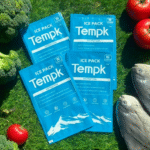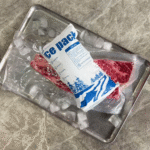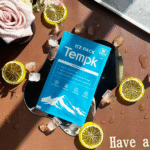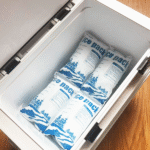Camping-Trockeneisbeutel: Ihr ultimativer Leitfaden für längere Frische
Planen Sie einen Campingausflug und fragen Sie sich, wie Sie Ihre Lebensmittel frisch halten können, ohne dass das Eis schmelzen muss? Trockeneisbeutel könnten die Lösung sein, nach der Sie suchen. Diese festen Kohlendioxidpackungen bieten eine kältere Alternative zu herkömmlichem Eis, Stellen Sie sicher, dass Ihre verderblichen Waren länger gefroren bleiben. In diesem Leitfaden, Wir werden die Vorteile untersuchen, Sicherheitsvorkehrungen, und Best Practices für die Verwendung von Trockeneisbeuteln bei Ihren Outdoor-Abenteuern.
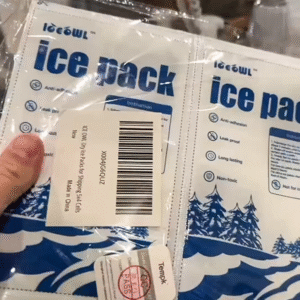
Warum wählen Trockeneis für Campen?
Trockeneisbeutel bieten gegenüber herkömmlichem Eis mehrere Vorteile, die Ihr Campingerlebnis verbessern können. Sie sind kalt genug, um mehrere Tage lang eisige Temperaturen aufrechtzuerhalten, die sich perfekt für die Aufbewahrung verderblicher Lebensmittel wie Fleisch eignet, Meeresfrüchte, und Tiefkühlgerichte sicher für längere Reisen. Da sie direkt vom Feststoff in den Gaszustand sublimieren, Es gibt keine Unordnung oder Wasserrückstände, über die man sich Sorgen machen müsste, Damit ist Trockeneis eine unglaublich effiziente Kühlmethode.
Der Hauptvorteile Camping mit Trockeneisbeuteln inklusive:
-
Verlängerte Kühldauer: Trockeneis kann Ihre Lebensmittel gefroren halten 2-3 Tage, viel länger als normales Eis.
-
Kein Durcheinander: Im Gegensatz zu normalem Eis, Trockeneis sublimiert und hinterlässt keine Wasserpfütze, So bleiben Ihre Lebensmittel und Ihre Kühlbox trocken.
-
Raumeffizienz: Trockeneis nimmt weniger Platz ein als herkömmliches Eis, So können Sie mehr Gegenstände in Ihre Kühlbox unterbringen.
-
Frische bewahren: Die extrem niedrigen Temperaturen von Trockeneis tragen dazu bei, Lebensmittel haltbar zu machen und den Verderb zu verhindern, damit alles länger frisch bleibt.
Was sind Trockeneisbeutel??
Trockeneisbeutel sind feste Blöcke oder Schichten aus CO₂, die bei Temperaturen von bis zu −78,5 °C direkt von einem Feststoff in ein Gas sublimieren (–109,3 ° F.). Dadurch sind sie viel kälter als normales Eis, Das ist festes Wasser bei 0°C. Denn Trockeneis sublimiert zu Gas, anstatt zu Wasser zu schmelzen, Es sorgt dafür, dass Ihre Kühlbox und Ihre Lebensmittel trocken bleiben, Verhinderung von Durchnässung, und das Einfrieren von Gegenständen, die eingefroren werden müssen, über einen längeren Zeitraum hinweg.
Wie vergleichen sich Camping-Trockeneisbeutel mit herkömmlichem Eis??
Um zu verstehen, ob Trockeneis die richtige Wahl für Ihre Reise ist, Vergleichen wir es mit herkömmlichem Eis und anderen Kühlmethoden. Hier ist eine Aufschlüsselung nebeneinander:
| Kühlmethode | Temperaturbereich | Kühldauer | Unordnung | Beste Anwendungsfälle | Was bedeutet dies für Sie |
|---|---|---|---|---|---|
| Trockeneisbeutel | –78,5 ° C. (SULBLIMATE) | 2-3 Tage oder mehr | Keiner (Sublimates zu Gas) | Lange Abenteuer, gefrorene Gegenstände | Hält Lebensmittel ohne Wasser gefroren, Ideal für lange Ausflüge mit Fleisch oder Eis. |
| Normales Eis | 0°C (Schmilzt zu Wasser) | 12-24 Std. | Hoch (Schmilzt zu Wasser) | Kurztrips, Getränke, gekühlte Artikel | Geeignet für Übernachtungs- oder Tagesausflüge, verursacht jedoch ein Durcheinander und hält die Lebensmittel nicht gefroren. |
| Gelpackungen | ~0°C bis 5°C | 12-36 Std. | Medium (Etwas Kondenswasser) | Frische Produkte, Getränke, Molkerei | Gut, um die Dinge kühl zu halten, nicht zum Einfrieren. |
| Phasenwechselmaterial (PCM) Packungen | 0°C bis −20 °C (Abstimmbar) | 2-4 Tage | Minimal | Hybridlösungen für gekühlte und gefrorene Produkte | Bietet eine kontrollierte Temperatur für gemischte Speisen. |
Trockeneisbeutel eignen sich perfekt zur Aufbewahrung von Lebensmitteln völlig gefroren Für längere Zeiträume, Im Gegensatz zu normalem Eis, die Gegenstände nur für eine begrenzte Zeit kühlt.
So verwenden Sie Trockeneisbeutel beim Camping sicher
Die Verwendung von Trockeneis erfordert einige Vorsichtsmaßnahmen, um sowohl Wirksamkeit als auch Sicherheit zu gewährleisten. So holen Sie das Beste aus Ihren Trockeneisbeuteln heraus:
-
Verwenden Sie Schutzausrüstung
Fassen Sie Trockeneis immer mit Handschuhen oder einer Zange an, um Erfrierungen zu vermeiden. -
Belüftung ist der Schlüssel
Denn Trockeneis sublimiert zu Kohlendioxid (Co₂) Gas, Stellen Sie sicher, dass Ihre Kühlbox ausreichend belüftet ist, damit das Gas entweichen kann. Dadurch wird eine gefährliche CO₂-Anreicherung verhindert, was zum Ersticken führen kann. -
Packen Sie Ihre Kühlbox effizient ein
-
Legen Sie Trockeneis darauf unten Ihres Kühlers für gleichmäßige Kühlung, Dadurch wird sichergestellt, dass Lebensmittel, die dem Trockeneis am nächsten sind, gefroren bleiben.
-
Füllen Sie alle leeren Stellen aus in der Kühlbox mit Isolierung wie zerknittertes Zeitungspapier, Handtücher, oder zusätzliches Trockeneis, um Luftspalte zu reduzieren, die die Sublimation erhöhen.
-
Trockeneis einwickeln mit Papier oder verwenden Sie eine Trockeneisbeutelhülle, um den direkten Kontakt mit Lebensmitteln zu verhindern, was zu Gefrierbrand führen kann.
-
-
Lassen Sie Platz für das Entweichen von CO₂-Gas
Stellen Sie sicher, dass etwas Platz für das Entweichen von CO₂-Gas vorhanden ist, um einen Druckaufbau zu vermeiden, Dies könnte Ihren Kühler beschädigen. -
Überwachen Sie die Temperatur
Für Gegenstände, die unter dem Gefrierpunkt bleiben müssen, Verwenden Sie regelmäßig ein Thermometer, um die Innentemperatur des Kühlers zu überprüfen.
So wählen Sie die richtigen Camping-Trockeneisbeutel für Ihre Reise aus?
Die Auswahl der richtigen Trockeneisbeutel für Ihren Campingausflug hängt von mehreren Faktoren ab, unter anderem von der Dauer Ihrer Reise, die Art des Kühlers, den Sie verwenden, und die Art der Lebensmittel, die Sie lagern möchten.
Für Kurztrips, Möglicherweise ist nur ein kleiner Kühler erforderlich 1-2 LBS Trockeneis, Bei längeren Reisen sind möglicherweise größere Blöcke oder mehr Trockeneis erforderlich, um optimale Gefriertemperaturen aufrechtzuerhalten. So planen Sie Ihre Bedürfnisse:
-
Wochenendausflüge (1-2 Tage): 2-4 LBS Trockeneis.
-
Ausgedehnte Reisen (3-5 Tage): 10-20 LBS Trockeneis.
-
Lange Expeditionen (5+ Tage): 25-50 LBS Trockeneis, plus normales Eis für zusätzliche Kühlung.
Tipp: Für Reisen in warme Klimazonen oder große Höhen, wo die Sublimationsraten schneller sind, Bringen Sie immer zusätzliches Trockeneis mit.
Neueste Trends bei Camping-Trockeneisbeuteln für 2025
Als technologische Fortschritte, Es gibt mehrere spannende Trends bei Camping-Trockeneisbeuteln, die die Kühlung im Freien noch effizienter und nachhaltiger machen.
-
Umweltfreundliche Innovationen: Es entstehen biologisch abbaubare Kühler und recycelbare Verpackungen, um Trockeneisprodukte nachhaltiger zu machen.
-
Smart Cooler: Kühler mit integrierten Temperatursensoren, Bluetooth-Konnektivität, Dank der mobilen App-Überwachung können Camper die Innentemperatur ihrer Kühlbox in Echtzeit verfolgen.
-
Hybridkühlungslösungen: Kombination von Trockeneis mit Phasenwechselmaterialien (PCMs) oder Gelpacks bieten eine flexible Lösung zur Temperaturkontrolle über längere Zeiträume.
Diese Innovationen machen es einfacher, Ihre Lebensmittel frisch zu halten, reduzieren gleichzeitig die Umweltbelastung und verbessern den Komfort.
Häufig gestellte Fragen (FAQs)
Q1: Wie unterscheiden sich Camping-Trockeneisbeutel von herkömmlichem Eis??
Camping-Trockeneisbeutel bieten eine länger anhaltende Kühlung, verhindert Wasserrückstände, und sind kompakter als herkömmliches Eis, Damit sind sie ideal für längere Reisen an abgelegenen Orten.
Q2: Wie lange dauert Trockeis in einem Kühler??
Trockeneis kann dazwischen dauern 24-48 Std., Abhängig von der Größe des Rucksacks und der Isolierung Ihrer Kühlbox. Für längere Reisen, Möglicherweise sind mehrere Trockeneisbeutel erforderlich.
Q3: Kann ich Trockeneis für kurze Campingausflüge verwenden??
Ja, Trockeneis eignet sich perfekt für kurze Campingausflüge, bei denen es auf Effizienz ankommt, Langanhaltende Kühlung ohne schmelzendes Eis.
Abschluss
Camping-Trockeneisbeutel sind eine hervorragende Lösung, um Ihre Speisen und Getränke bei Outdoor-Abenteuern kühl zu halten. Egal, ob Sie einen Wochenendausflug oder eine längere Reise planen, Trockeneisbeutel können Ihre Lebensmittel frisch halten und verhindern, dass sie verderben, Und das alles ist platzsparender als herkömmliches Eis. Indem Sie den richtigen Trockeneisbeutel auswählen und ihn richtig verwenden, Sie können Ihr Campingerlebnis verbessern und während Ihrer Reise frische Mahlzeiten und Getränke genießen.
Über Tempk
Tempk ist ein vertrauenswürdiger Anbieter von Kühlkettenlösungen, Wir bieten leistungsstarke Trockeneis-Akkus an, PCM-Kältemittel, und isolierte Behälter. Mit Fokus auf Nachhaltigkeit und Innovation, Wir entwerfen Produkte, die wiederverwendbar sind, umweltfreundlich, und maßgeschneidert für Camping und Outdoor-Einsatz.
















